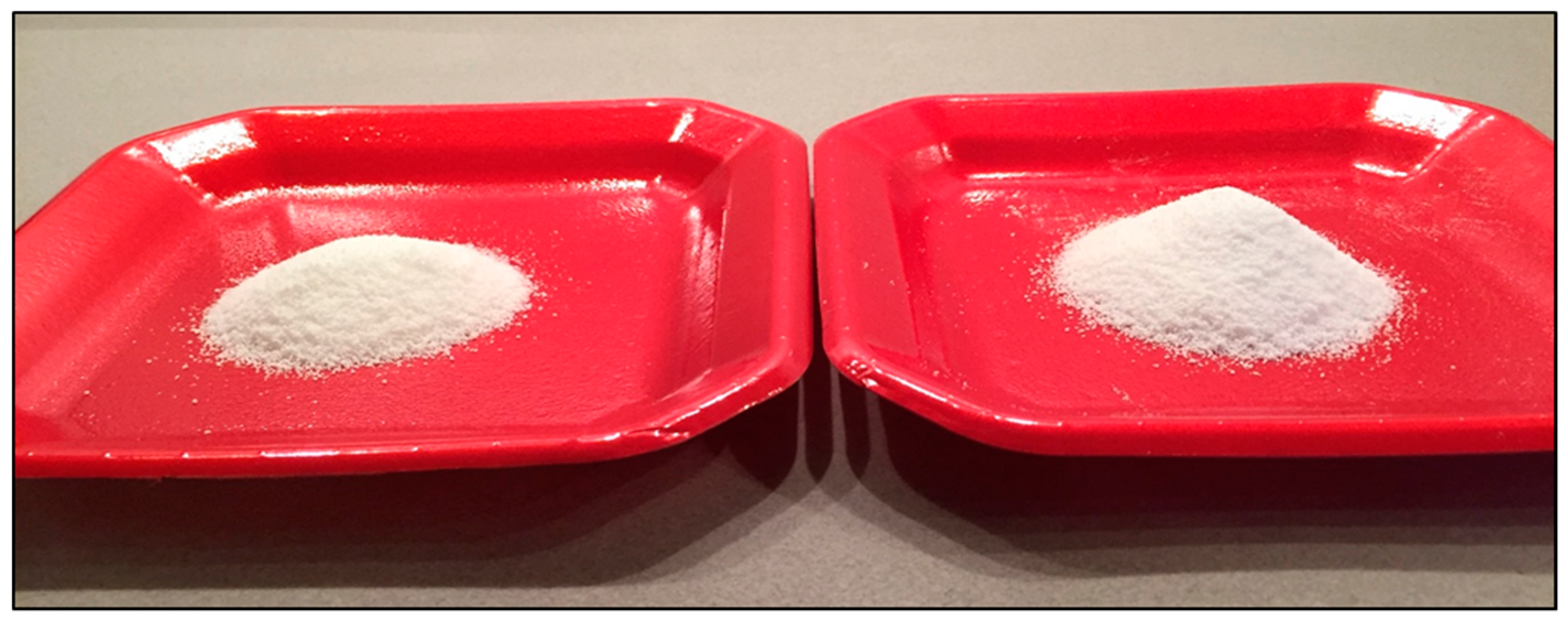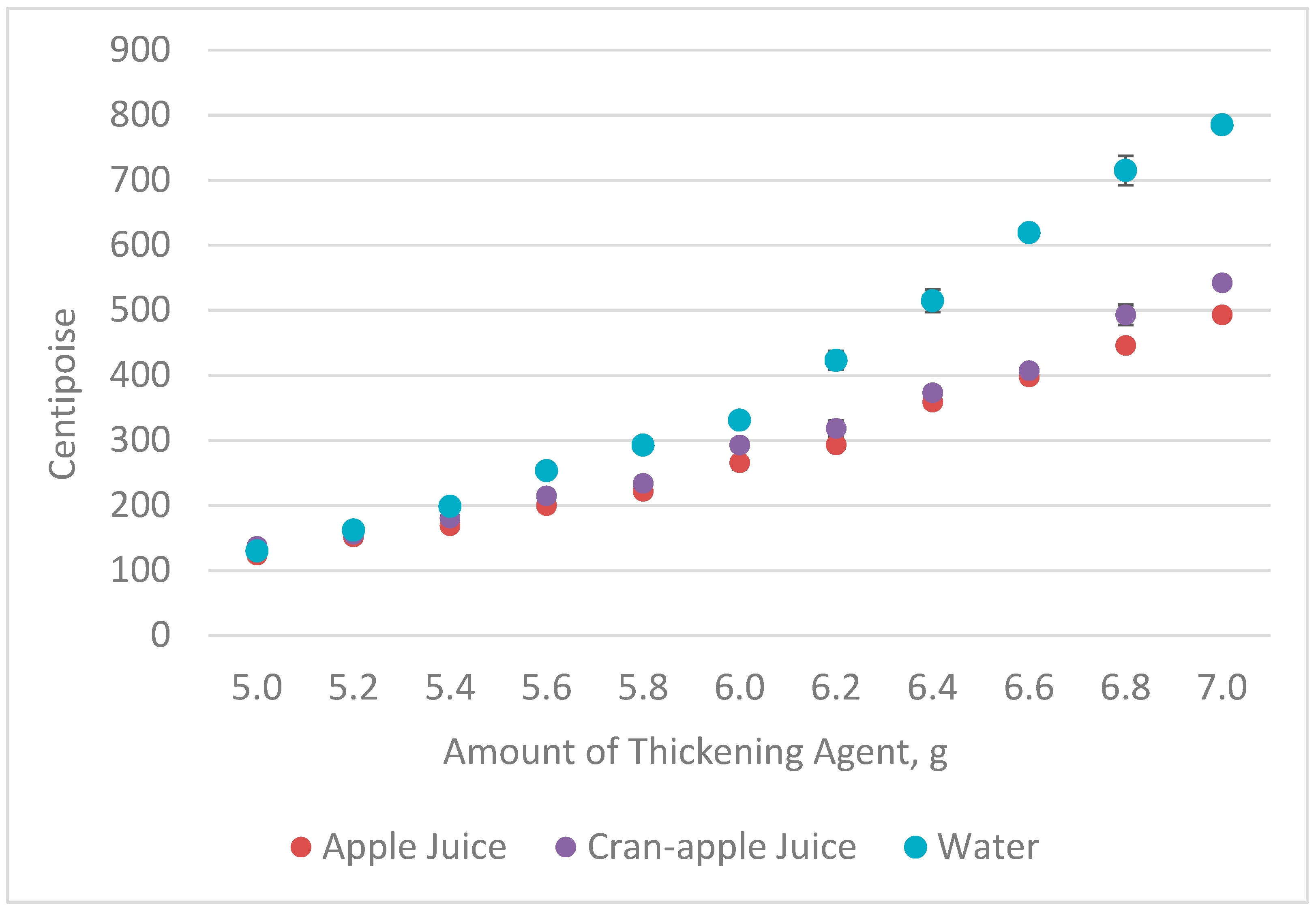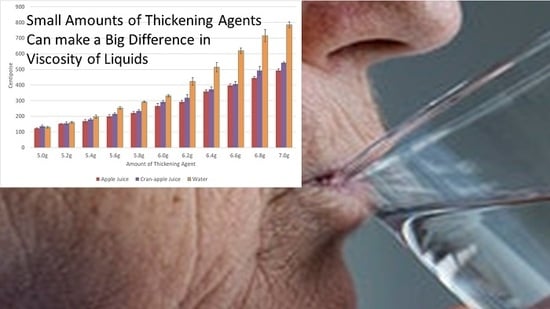Incremental Adjustments to Amount of Thickening Agent in Beverages: Implications for Clinical Practitioners Who Oversee Nutrition Care Involving Thickened Liquids
Abstract
:1. Introduction
2. Materials and Methods
2.1. Sample Preparation Procedure
2.2. Viscosity Measurement
2.3. Statistical Analysis
3. Results
4. Discussion
5. Limitations
6. Conclusions
Author Contributions
Funding
Acknowledgments
Conflicts of Interest
References
- Garcia, J.M.; Chambers, E., IV; Molander, M. Thickened Liquids. Am. J. Speech Lang Pathol. 2005, 14, 4–13. [Google Scholar] [CrossRef]
- Garcia, J.M.; Iv, E.C.; Helverson, J.; Matta, Z.; Clark, M. Quality of care issues for dysphagia: Modifications involving oral fluids. J. Clin. Nurs. 2010, 19, 1618–1624. [Google Scholar] [CrossRef] [PubMed]
- Garcia, J.M.; Chambers, E., IV. Perspectives of Registered Dietitians About Thickened Beverages in Nutrition Management of Dysphagia. Top. Clin. Nutr. 2012, 27, 105–113. [Google Scholar] [CrossRef]
- Lam, P.; Hanson, B.; Chen, J.; Duivestein, J.; Kayashita, J.; Lecko, C.; Murray, J.; Pillay, M.; Riquelme, L.; Stanschus, S.; et al. Development of International Terminology and Definitions for Texture-Modified Foods and Thickened Fluids Used in Dysphagia Management: The IDDSI Framework. Dysphagia 2016, 32, 293–314. [Google Scholar]
- Glassburn, D.L.; Deem, J.F. Thickener Viscosity in Dysphagia Management: Variability among Speech-Language Pathologists. Dysphagia 1998, 13, 218–222. [Google Scholar] [CrossRef] [PubMed]
- Cichero, J.A. Thickening agents used for dysphagia management: Effect on bioavailability of water, medication and feelings of satiety. Nutr. J. 2013, 12, 54. [Google Scholar] [CrossRef]
- Judson, B.L.; Sliwinski, E.; Madson, L.; Leder, S.B. Promoting Safe Swallowing When Puree is Swallowed Without Aspiration but Thin Liquid is Aspirated: Nectar is Enough. Dysphagia 2012, 28, 58–62. [Google Scholar]
- Steele, C.M.; Alsanei, W.A.; Ayanikalath, S.; Barbon, C.E.A.; Chen, J.; Cichero, J.A.Y.; Coutts, K.; Dantas, R.O.; Duivestein, J.; Giosa, L.; et al. Erratum to: The Influence of Food Texture and Liquid Consistency Modification on Swallowing Physiology and Function: A Systematic Review. Dysphagia 2015, 30, 272–273. [Google Scholar] [CrossRef]
- Robbins, J.; Gensler, G.; Hind, J.; Logemann, J.A.; Lindblad, A.S.; Brandt, D.; Baum, H.; Lilienfeld, D.; Kosek, S.; Lundy, D.; et al. Comparison of 2 Interventions for Liquid Aspiration on Pneumonia Incidence. Ann. Intern. Med. 2008, 148, 509–518. [Google Scholar] [CrossRef]
- Lotong, V.; Chun, S.S.; Chambers, E., IV; Garcia, J.M. Texture and Flavor Characteristics of beverages containing commercial thickening agents for dysphagia diets. J. Food Sci. 2003, 68, 1537–1541. [Google Scholar] [CrossRef]
- Matta, Z.; Chambers, E., IV; Garcia, J.M.; Helverson, J. Sensory characteristics of five beverages prepared with commercial thickeners used for dysphagia diets. J. Am. Dietet. Assoc. 2006, 106, 1049–1054. [Google Scholar] [CrossRef] [PubMed]
- Park, J.H.; Kim, H.-G.; Oh, B.-M.; Lee, M.-W.; Hwang, I.-K.; Lee, S.-U.; Han, T.R. Comparison of Different Gum-Based Thickeners Using a Viscometer and Line Spread Test: A Preliminary Study. Ann. Rehabil. Med. 2014, 38, 94–100. [Google Scholar] [CrossRef] [PubMed]
- National Dysphagia Diet Task Force. National Dysphagia Diet: Standardization for Optimal Care; American Dietetic Association: Chicago, IL, USA, 2008. [Google Scholar]
- Gregerson, J. Thick and thin: Tools to manage viscosity. Starches and gums can help to get it just right. Food Process. 2002, 63, 108–109. [Google Scholar]
- Hirashima, M.; Takahashi, R.; Nishinary, K. Effects of adding acids before and after gelatinization on the viscoelasticity of corn starch pastes. Food Hydrocol. 2005, 19, 909–914. [Google Scholar] [CrossRef]
- Majzoobi, M.; Beparva, P.; Farahnaky, A.; Badii, F. Effects of malic acid and citric acid on the functional properties of native and cross-linked wheat starches. Starch—Stärke 2013, 66, 491–495. [Google Scholar] [CrossRef]
- Steele, C.M.; James, D.F.; Hori, S.; Polacco, R.C.; Yee, C. Oral Perceptual Discrimination of Viscosity Differences for Non-Newtonian Liquids in the Nectar- and Honey-Thick Ranges. Dysphagia 2014, 29, 355–364. [Google Scholar] [CrossRef] [PubMed]
- Chambers, E., IV; Jenkins, A.; Garcia, J.M. Sensory texture analysis of thickened liquids during ingestion. J. Texture Stud. 2017, 48, 518–529. [Google Scholar] [CrossRef]
- Garcia, J.M.; Chambers, E., IV; Matta, Z.; Clark, M.; Iv, E.C. Viscosity Measurements of Nectar- and Honey-thick Liquids: Product, Liquid, and Time Comparisons. Dysphagia 2005, 20, 325–335. [Google Scholar] [CrossRef]
- Adeleye, B.; Rachal, C. Comparison of the Rheological Properties of Ready-to-Serve and Powdered Instant Food–Thickened Beverages at Different Temperatures for Dysphagic Patients. J. Am. Diet. Assoc. 2007, 107, 1176–1182. [Google Scholar] [CrossRef]
- Barbon, C.E.A.; Steele, C.M. Characterizing the Flow of Thickened Barium and Non-barium Liquid Recipes Using the IDDSI Flow Test. Dysphagia 2018, 34, 73–79. [Google Scholar] [CrossRef]
- Garcia, J.M.; Chambers, E., IV; Matta, Z.; Clark, M.; Iv, E.C. Serving Temperature Viscosity Measurements of Nectar- and Honey-Thick Liquids. Dysphagia 2007, 23, 65–75. [Google Scholar] [CrossRef] [PubMed]
- Payne, C.; Methven, L.; Fairfield, C.; Gosney, M.; Bell, A.E. Variability of starch-based thickened drinks for patients with dysphagia in the hospital setting. J. Texture Stud. 2011, 43, 95–105. [Google Scholar] [CrossRef]
- Pelletier, C.A. Feeding beliefs of certified nurse assistants in the nursing home: A factor influencing practice. J. Gerontol. Nurs. 2005, 31, 5–10. [Google Scholar] [CrossRef] [PubMed]
- Smith, C.H.; Jebson, E.M.; Hanson, B. Thickened fluids: Investigation of users’ experiences and perceptions. Clin. Nutr. 2014, 33, 171–174. [Google Scholar] [CrossRef] [PubMed]
- IDDSI. IDDSI Drink Testing Methods—IDDSI FLow Test. International Dysphagia Diet Standarisation Initiative, 2016. Available online: http://iddsi.org/framework/drink-testing-methods/ (accessed on 7 August 2018).
- Garcia, J.M.; Chambers, E., IV; Cook, K. Visualizing the Consistency of Thickened Liquids with Simple Tools: Implications for Clinical Practice. Am. J. Speech Lang Pathol. 2018, 27, 270–277. [Google Scholar] [CrossRef] [PubMed]


| Thickening Agent (in Grams) | Apple Juice Mean (Stf Dev.) | Cran-Apple Juice Mean (Std. Dev.) | Water Mean (Std. Dev.) |
|---|---|---|---|
| 5.0 g | 123.6 (2.7) | 136.9 (8.0) | 130.0 (5.4) |
| 5.2 g | 151.7 (1.7) | 155.8 (9.3) | 162.0 (6.2) |
| 5.4 g | 168.9 (11.5) | 180.5 (5.0) | 198.6 (11.3) |
| 5.6 g | 199.7 (10.5) | 214.7 (7.5) | 253.3 (8.8) |
| 5.8 g | 221.7 (8.7) | 233.9 (7.2) | 292.8 (4.1) |
| 6.0 g | 265.6 (17.8) | 292.8 (9.5) | 330.9 (7.2) |
| 6.2 g | 293.1 (9.3) | 318.3 (21.0) | 423.1 (24.2) |
| 6.4 g | 358.9 (11.5) | 373.1 (15.8) | 514.7 (30.1) |
| 6.6 g | 397.5 (8.8) | 407.2 (14.5) | 619.4 (17.9) |
| 6.8 g | 445.8 (9.0) | 492.8 (26.7) | 715.0 (38.8) |
| 7.0 g | 492.8 (9.3) | 542.2 (5.4) | 785.0 (18.6) |
© 2019 by the authors. Licensee MDPI, Basel, Switzerland. This article is an open access article distributed under the terms and conditions of the Creative Commons Attribution (CC BY) license (http://creativecommons.org/licenses/by/4.0/).
Share and Cite
Garcia, J.M.; Chambers, E., IV. Incremental Adjustments to Amount of Thickening Agent in Beverages: Implications for Clinical Practitioners Who Oversee Nutrition Care Involving Thickened Liquids. Foods 2019, 8, 74. https://doi.org/10.3390/foods8020074
Garcia JM, Chambers E IV. Incremental Adjustments to Amount of Thickening Agent in Beverages: Implications for Clinical Practitioners Who Oversee Nutrition Care Involving Thickened Liquids. Foods. 2019; 8(2):74. https://doi.org/10.3390/foods8020074
Chicago/Turabian StyleGarcia, Jane Mertz, and Edgar Chambers, IV. 2019. "Incremental Adjustments to Amount of Thickening Agent in Beverages: Implications for Clinical Practitioners Who Oversee Nutrition Care Involving Thickened Liquids" Foods 8, no. 2: 74. https://doi.org/10.3390/foods8020074
APA StyleGarcia, J. M., & Chambers, E., IV. (2019). Incremental Adjustments to Amount of Thickening Agent in Beverages: Implications for Clinical Practitioners Who Oversee Nutrition Care Involving Thickened Liquids. Foods, 8(2), 74. https://doi.org/10.3390/foods8020074







